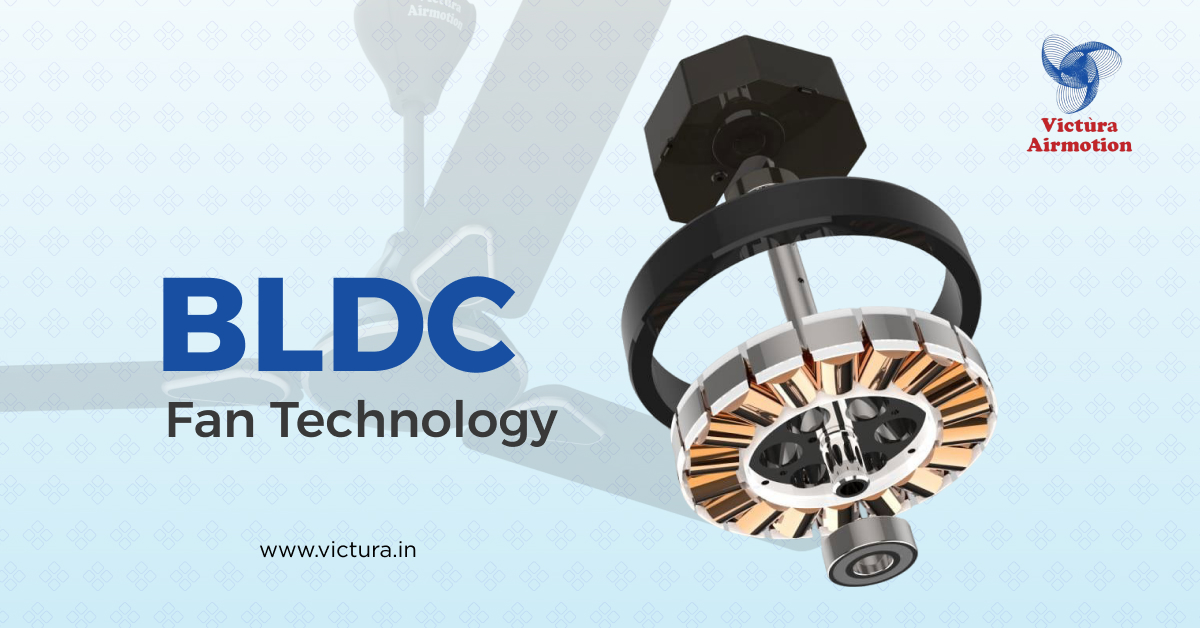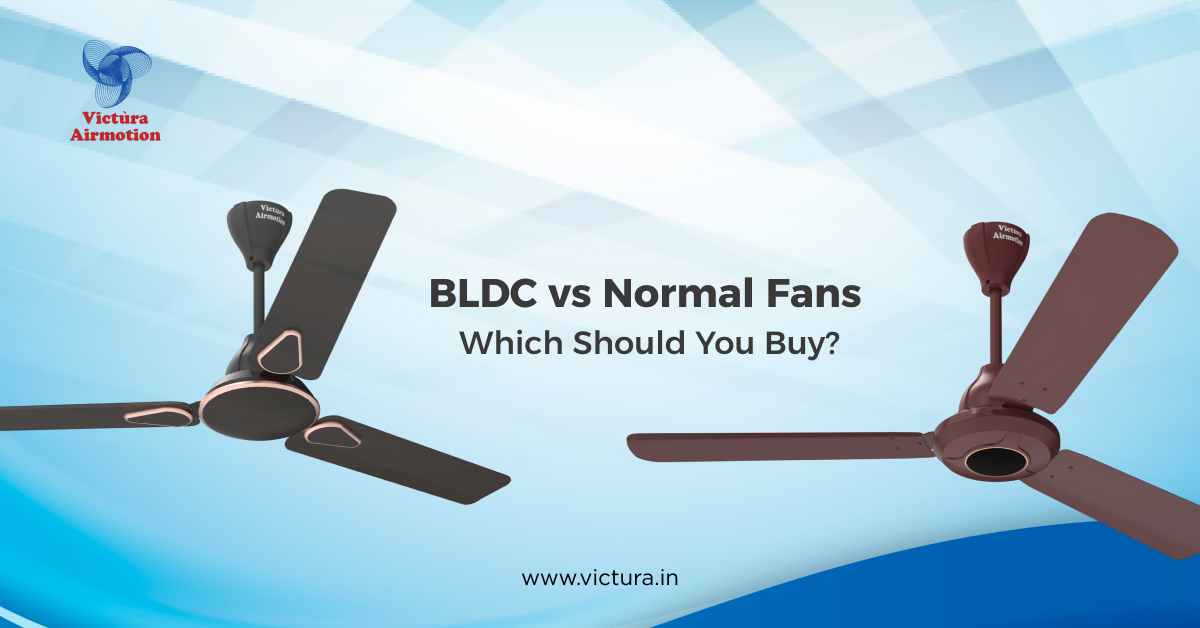BLDC fans are all the rage right now. With all its merits, it poses the question: which is better BLDC vs normal fan? After learning about its low power consumption, high air delivery, and money-saving capabilities, this is the moment you start wondering, “Do I need a better fan?”
But what makes BLDC fans different? Are they worth your money? In this blog, you’re going to learn about what makes BLDC fans tick, the advantages and disadvantages they bring, along with what makes them different from regular fans. Come, let’s dive into this rabbit hole together.
What is BLDC fan technology?
“Brushless Direct Current” is what powers a BLDC fan. A regular, traditional fan uses the age-old AC (Alternating Current) technology, which uses motors with brushes. These fans suck up too much power and money, while also creating a lot of noise.
On the other hand, the smart BLDC technology runs on DC (Direct Current) with brushless motors, saving power, bills, and the aesthetic of your home.
No brushes means less friction, less heat, and way more efficiency. But this isn’t just a fancy engineering upgrade — BLDC fans are genuinely changing the game when it comes to cooling your space with smarter energy usage.
Advantages of BLDC fans
BLDC fans are new; normal fans have been around way longer. So, why are people going for this switch suddenly?
1. Massive Energy Savings
A common BLDC fan is a low watt ceiling fan, using 28-35 watts, while old-style fans suck up 70-80 watts. That cuts more than 60% from your fan’s power use.
2. Inverter Friendly
Because they need less power, BLDC fans can run longer on inverters during power cuts — a quiet hero in Indian households.
3. Silent Operation
No more humming at night. BLDC fans make very little sound with their no-brush tech.
4. Remote Control & Smart Features
Many BLDC fans have remotes, timers, and even apps.
5. Longer Life
Less friction = less wear and tear = more life.
Disadvantages of BLDC fans
No technology is perfect, and BLDC fans have their own quirks:
1. Higher Initial Cost
They cost more than standard fans, often by 30-50%.
2. Service Availability
Still a growing technology, which means fewer technicians are familiar with repair and parts in smaller towns.
3. Dependency on Circuitry
If the control circuit fails, the fan becomes unusable, unlike normal fans, which can work with minor repairs.
4. Limited Models in Some Brands
Not all fan models have a BLDC version, especially in decorative or specialty variants.
Differences Between BLDC vs Normal Fan
Let’s break it down across ten crucial factors:
1. Energy efficiency
BLDC Fans: Clear winner. Consumes very little energy compared to normal fans (about 65% less).
Normal Fans: More power-wasting. Good for the past, not for modern energy-conscious homes.
2. Noise and friction
BLDC Fans: Almost silent due to brushless motors.
Normal Fans: Tend to make a humming noise, especially at high speeds or with age.
3. Lifespan and maintenance
BLDC Fans: Fewer parts moving means they last longer.
Normal Fans: Parts wear out quickly and need more fixes often.
4. Cost
BLDC Fans: Cost more at purchase, but save money later.
Normal Fans: Cheap to buy, yet cost more on power bills over time.
5. Size and placement
BLDC Fans: Small motors make for a thin look; great for new-style homes.
Normal Fans: Big motors; may look old in new homes.

6. Air Delivery
BLDC Fans: As good or better air moves than normal fans, more so in top models.
Normal Fans: Moves air well, but not great with saving energy.
7. Special Features or Modes
BLDC Fans: Often include boost mode, sleep timer, breeze mode, and remote control.
Normal Fans: Usually lack advanced features; some models may have basic regulators or pull chains.
8. Ease of Installation
BLDC Fans: Standard mounting, but may require extra care during wiring due to control circuitry.
Normal Fans: Familiar to every electrician; plug and play with almost zero learning curve.
9. Consistent Performance
BLDC Fans: Standard mounting, but may require extra care during wiring due to control circuitry.
Normal Fans: Familiar to every electrician; plug and play with almost zero learning curve.
10. Sweep Size
Both BLDC and normal fans come in common sweep sizes like 1200mm, 1400mm, and 900mm, depending on the room size.
No clear winner here, but premium BLDC fans may offer more efficiency at larger sweeps.
BLDC vs Normal fan: A Greener Choice for the Planet
BLDC fans do more than cut your power bill; they help the planet in a big way:
1. Less Carbon Use
Using up to 65% less energy means less coal and gas are used where they make power. Think of this in millions of homes, and the change is huge.
2. Less Heat Made
Old fans make more heat because of friction, which makes rooms hotter, even more so in small, shut rooms. BLDC fans keep cool, making your space comfy in a natural way.
3. Works Well with Solar Power
If your home uses solar power, BLDC fans are perfect. They need so little power that they run longer on solar or batteries without too much load.
So, if you’re moving to a BLDC fan, you’re not just getting new tech, you’re making a small yet big move for a greener tomorrow. And that’s an easy win to go after.
So, Which Fan Should You Buy?
Let’s make this simple:
Buy a BLDC Fan If:
- You want long-term energy savings.
- You deal with frequent power cuts or voltage drops.
- You love modern comforts like remote controls and smart features.
- You’re planning for the future of sustainable living.
Stick to a Normal Fan If:
- Your budget is tight.
- You live in a temporary setup or rental.
- You want something basic for occasional use (like a storeroom or terrace).
Conclusion
So, do you know now which is better for you: BLDC vs normal fan? It’s obvious BLDC is the better choice. They stay functional for a long time, they run all day, and they change how comfy you are and your costs.
BLDC fans may look cool and new now, but they will soon become the usual pick in homes that think of power use. They do more than cool your space; they drop your costs, make less noise, and often help cut your carbon mark too.
So, if you want a smart change, it might be time to let your old fan go — and bring in a new, quiet, smart, better one.
See More: Latest Ceiling Fan
Frequently Asked Questions
Q1. Which fan is better BLDC or normal?
BLDC fans are good due to their high saving of power, quiet work, long life, and smart traits — but they cost more first.
Q2. What is the full form of BLDC fan?
BLDC stands for Brushless Direct Current fan.
Q3. What are the disadvantages of BLDC fans?
They cost more to buy, need electronic parts (which may be hard to fix), and might be hard to find in some stores or places.
Q4. Is BLDC fan less noisy?
Yes, BLDC fans make less noise than normal fans because they do not have brushes, which cuts down on rubbing and motor noise.
Q5. Are BLDC fans slower than normal?
Not at all. BLDC fans often give the same or even more air flow than normal fans, with steady speed even when power goes up and down.
